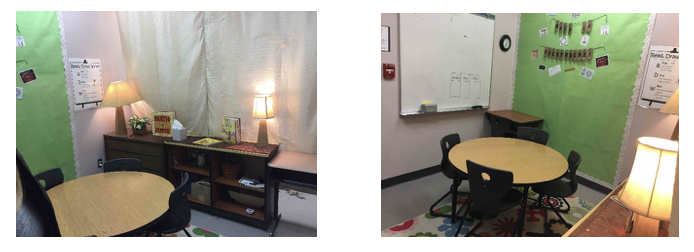Tight Spaces and Tighter Budgets
Join Our Community
Access this resource now. Get up to three resources every month for free.
Choose from thousands of articles, lessons, guides, videos, and printables.
Our school is crowded, despite being remodeled and enlarged just four years ago. Like many schools these days, we have more and more students moving into the area. So we find ourselves having to get creative with space, especially for teachers who work with small groups or one-on-one. At first, we sectioned off classrooms so that we could share space, but now those rooms are full of students.
Schools can get creative with space in two ways: begin a push-in model or repurpose conference rooms and closets. If you’re considering a push-in model, you’ll need traveling tools.
Here are a few things to consider before embarking on a push-in model:
- Are the classroom teachers on board with this idea?
- How many students would I work with at a time in each room?
- Would there be a spot for me to work with students in the room?
- Would this be disruptive to the rest of the class?
- What materials would I need?
- Is there a place to store materials or would I need to transport them daily?
Here are a few things to consider before repurposing a space:
- Do I have permission to use the space, and would I need to share it?
- How many students would I need to work with in this space?
- Is it safe and in proximity to the students who will use it?
- Would I need to store materials there?
- What furniture would I need to procure?
- What is the lighting like?
- Would I need to mask any visual noise?
- How could I make the space feel inviting?
- Do I have a budget to make changes?
Despite having no budget, we successfully repurposed two cluttered, unappealing teacher conference rooms that were being used for storage. Take a look at the “before” photos of one space:

The materials being stored in the room were current and important to the classroom teachers, so we got creative with storage and reducing the visual noise:
- We used the whiteboard as an anchor, put up a bulletin board, and decluttered the shelves.
- We brought in a small round table, a rug, and a dresser that I found and cleaned up.
- We organized all the books into the dresser so that they were hidden but still accessible to teachers.
- We installed lamps (free from a family member) and hung curtains (free from Facebook friends) to mask the huge plastic tubs.

We were excited about our results. It definitely took some time to procure items and an appealing learning space right next door to their classrooms. The specialist has a workable space to meet with a small group and even a couple of desks for students to spread out. My favorite part is the round table, which fits perfectly and makes the space feel collaborative.
When you are challenged with finding instruction spaces in your school, don’t rule out storage areas. Any space can be made more appealing and comfortable by using neutral tones, reducing clutter and visual noise, and softening the space with lamps, plants, and rugs. Here’s the other closet in which we created a teaching space.

The furniture and supplies in this room were all shared by teachers who weren’t using them and were happy to see them put to good use. It’s amazing what can happen when a community realizes the power of functional, inviting spaces. We all worked together to create the best learning environments possible for our learners, and it’s paying off.
Is your building beginning to feel growing pains? Get creative with space and materials. Even if you have no budget, you can create welcoming, workable spaces for students.





